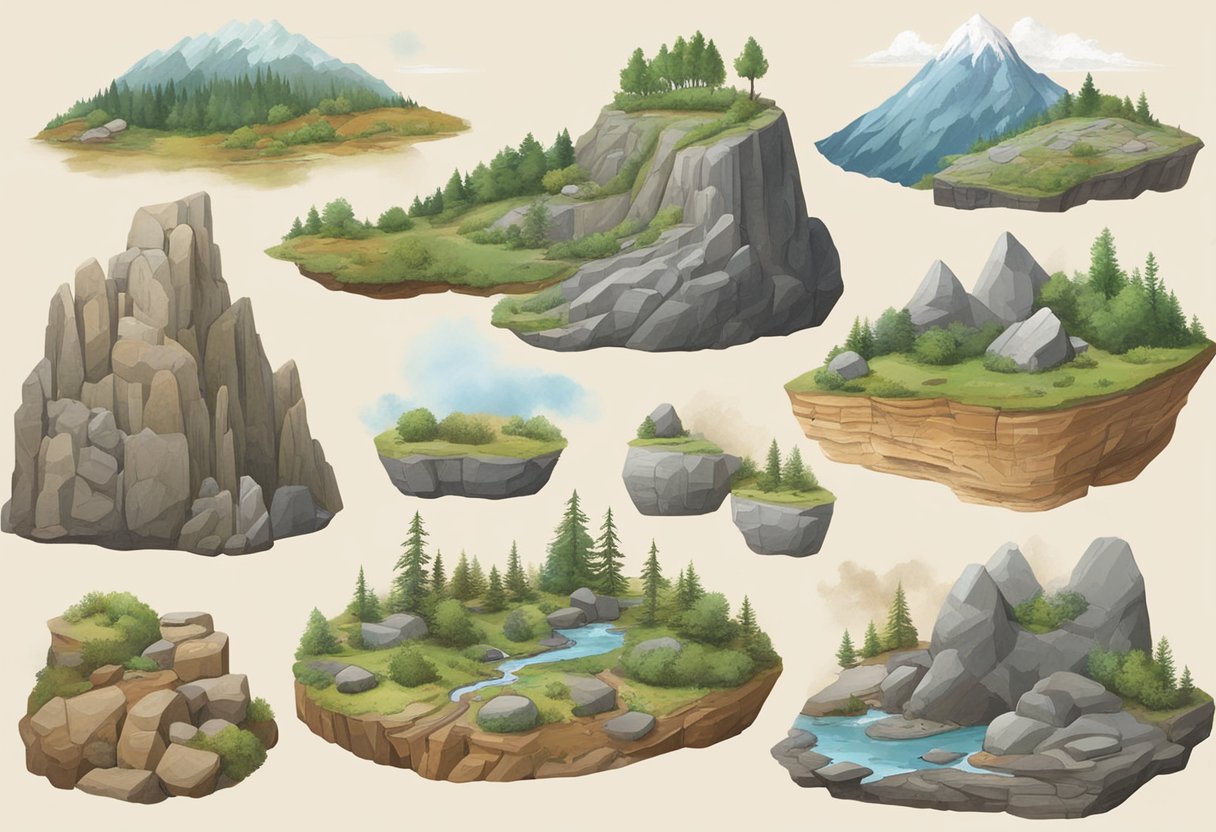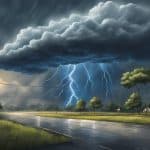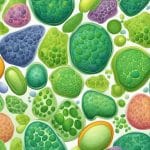Types Of Weathering
Weathering is a natural process that occurs on the Earth’s surface and is responsible for shaping the landscape around us. It is the breakdown of rocks and minerals into smaller particles due to various agents, including physical, chemical, and biological mechanisms. Understanding the different types of weathering and their impact on landscapes is essential for geologists, environmental scientists, and anyone interested in the natural world.
There are three main types of weathering: physical, chemical, and biological. Physical weathering processes include freeze-thaw, exfoliation, and abrasion, which break down rocks and minerals through physical means, such as temperature changes, pressure, and mechanical forces. Chemical weathering agents, such as water, acids, and oxygen, chemically react with rocks and minerals, causing them to break down into smaller particles. Biological weathering mechanisms, such as the action of plant roots, burrowing animals, and microorganisms, also contribute to weathering by physically breaking down rocks and minerals or chemically altering them.
Understanding the different types of weathering and their mechanisms is crucial for understanding how landscapes are formed and how they change over time. By studying the effects of weathering on rocks and minerals, scientists can gain insight into the Earth’s geological history and how it has evolved over millions of years.
Key Takeaways
- Weathering is the natural process of breaking down rocks and minerals on the Earth’s surface.
- There are three main types of weathering: physical, chemical, and biological.
- Understanding the different types of weathering and their mechanisms is crucial for understanding the Earth’s geological history and how landscapes are formed and change over time.
Types of Weathering

Weathering is the process by which rocks and minerals are broken down into smaller pieces. There are three main types of weathering: physical, chemical, and biological weathering.
Physical Weathering
Physical weathering, also known as mechanical weathering, is the process by which rocks are broken down into smaller pieces without any change in their chemical composition. This type of weathering occurs due to physical forces such as temperature changes, freezing and thawing, and abrasion.
Temperature changes cause rocks to expand and contract, which can lead to the formation of cracks. When water enters these cracks and freezes, it expands and causes the rock to break apart. This is known as freeze-thaw weathering.
Abrasion occurs when rocks are physically worn down by other rocks, sand, or water. This can lead to the formation of smooth, rounded rocks.
Chemical Weathering
Chemical weathering is the process by which rocks are broken down into smaller pieces through chemical reactions. This type of weathering occurs due to the action of acids, water, and other chemicals.
Acid rain is a common cause of chemical weathering. When rainwater combines with pollutants in the air, it becomes acidic and can dissolve rocks and minerals.
Water can also cause chemical weathering by dissolving minerals in rocks. This can lead to the formation of caves and sinkholes.
Biological Weathering
Biological weathering is the process by which rocks are broken down into smaller pieces by living organisms. This type of weathering occurs due to the action of plants, animals, and microorganisms.
Plants can cause physical weathering by growing roots into cracks in rocks. As the roots grow, they can push the rock apart.
Animals can also cause physical weathering by burrowing into rocks. This can lead to the formation of tunnels and other structures.
Microorganisms can cause chemical weathering by producing acids that dissolve rocks and minerals. This can lead to the formation of soil and other organic materials.
In conclusion, weathering is a natural process that occurs due to a variety of physical, chemical, and biological factors. Understanding the different types of weathering can help us better understand the natural world around us.
Physical Weathering Processes
Physical weathering, also known as mechanical weathering, is the class of processes that causes the disintegration of rocks without chemical change. The primary process in physical weathering is abrasion (the process by which clasts and other particles are reduced in size). There are various physical weathering processes, including frost weathering, thermal stress, and exfoliation.
Frost Weathering
Frost weathering, also known as freeze-thaw weathering, occurs when water freezes in the cracks of rocks, expands, and causes the rocks to break apart. The repeated freezing and thawing of water within the cracks of rocks can cause the rocks to break down into smaller pieces. This process is particularly common in areas with cold temperatures and frequent freeze-thaw cycles.
Thermal Stress
Thermal stress occurs when rocks experience changes in temperature, causing them to expand and contract. This process can cause rocks to crack and break apart. Thermal stress is most common in areas with extreme temperature fluctuations, such as deserts or areas with volcanic activity.
Exfoliation
Exfoliation occurs when the outer layers of rocks peel away due to changes in temperature or pressure. This process is most common in areas with large temperature fluctuations, such as deserts or mountainous regions. As the outer layers of the rock peel away, the underlying layers are exposed, leading to the formation of unique rock formations.
Overall, physical weathering processes are an important part of the natural breakdown of rocks and minerals. These processes can be influenced by various factors, including temperature, water, ice, wind, and more. Understanding the different types of physical weathering processes can help us better understand the natural world around us.
Chemical Weathering Agents
Chemical weathering is the process by which rocks are broken down by chemical reactions. There are various agents of chemical weathering that contribute to this process. Some of the most important agents of chemical weathering are hydrolysis, oxidation, and carbonation.
Hydrolysis
Hydrolysis is a chemical reaction in which water reacts with minerals in rocks, causing them to break down. This process is particularly effective in breaking down minerals that contain aluminum or iron. When water reacts with these minerals, it forms new minerals that are more stable in the presence of water. The new minerals are often softer and more easily eroded than the original minerals.
Oxidation
Oxidation is a chemical reaction in which oxygen reacts with minerals in rocks, causing them to break down. This process is particularly effective in breaking down minerals that contain iron or sulfur. When oxygen reacts with these minerals, it forms new minerals that are more stable in the presence of oxygen. The new minerals are often softer and more easily eroded than the original minerals.
Carbonation
Carbonation is a chemical reaction in which carbon dioxide reacts with minerals in rocks, causing them to break down. This process is particularly effective in breaking down minerals that contain calcium or magnesium. When carbon dioxide reacts with these minerals, it forms new minerals that are more stable in the presence of carbon dioxide. The new minerals are often softer and more easily eroded than the original minerals.
Overall, chemical weathering is an important process that contributes to the breakdown of rocks over time. The agents of chemical weathering, including hydrolysis, oxidation, and carbonation, all play important roles in this process. Understanding these agents and their effects can help us better understand the geology of our planet.
Biological Weathering Mechanisms
Biological weathering is the process of rock breakdown caused by living organisms. It is an important process that contributes to soil formation and nutrient cycling. This section will discuss some of the mechanisms that contribute to biological weathering.
Plant and Tree Roots
One of the most common mechanisms of biological weathering is the growth of plant and tree roots. As the roots grow, they exert pressure on the surrounding rocks, causing them to crack and break apart. This process is known as physical weathering. In addition, the roots release organic acids that can dissolve minerals in the rocks, leading to chemical weathering.
Microbial Activity
Microbes such as bacteria and lichens are also important contributors to biological weathering. These organisms can produce organic acids that can dissolve minerals in the rocks. In addition, some microbes can produce enzymes that break down organic matter in the soil, releasing nutrients that can be used by other organisms.
Animal Movements
Animals can also contribute to biological weathering through their movements. For example, burrowing animals such as moles and gophers can loosen soil and break apart rocks as they dig their burrows. In addition, the waste products of animals can contribute to soil formation and nutrient cycling.
Overall, biological weathering is an important process that contributes to soil formation and nutrient cycling. Plant and tree roots, microbial activity, and animal movements are some of the mechanisms that contribute to this process.
Weathering Impact on Landscapes
Weathering plays a vital role in shaping the Earth’s landscapes. The process of weathering breaks down rocks, soil, and minerals into smaller pieces, which eventually transforms into sediment. The different types of weathering, including mechanical, organic, and chemical weathering, all contribute to the alteration of landscapes over time.
Mechanical weathering, also known as physical weathering, occurs when rocks are broken down into smaller pieces without any change in their chemical composition. This type of weathering can be caused by several factors, including freezing and thawing of water, plant root growth, and abrasion by wind or water. Mechanical weathering can lead to the formation of various landforms, such as canyons, valleys, and cliffs.
Chemical weathering occurs when rocks are broken down through chemical reactions, leading to changes in their chemical composition. This type of weathering can be caused by several factors, including exposure to water, air, and acids. Chemical weathering can lead to the formation of various landforms, such as caves, sinkholes, and karst landscapes.
Organic weathering occurs when rocks are broken down by the actions of living organisms, such as plants and animals. This type of weathering can be caused by several factors, including the growth of plant roots, the burrowing of animals, and the action of bacteria. Organic weathering can lead to the formation of various landforms, such as soil and sediment.
Human activities can also contribute to weathering and the alteration of landscapes. Activities such as mining, quarrying, and construction can lead to the physical and chemical breakdown of rocks, soil, and minerals. Human activities can also lead to the alteration of landscapes through erosion, deforestation, and the introduction of invasive species.
In conclusion, weathering plays a crucial role in shaping the Earth’s landscapes. The different types of weathering, including mechanical, organic, and chemical weathering, all contribute to the alteration of landscapes over time. Human activities can also contribute to weathering and the alteration of landscapes.






